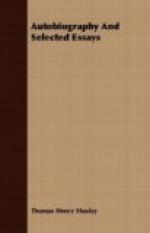Protoplasm, simple or nucleated, is the formal basis of all life. It is the clay of the potter: which, bake it and paint it as he will, remains clay, separated by artifice, and not by nature, from the commonest brick or sun-dried clod.
Thus it becomes clear that all living powers are cognate, and that all living forms are fundamentally of one character. The researches of the chemist have revealed a no less striking uniformity of material composition in living matter.
In perfect strictness, it is true that chemical investigation can tell us little or nothing, directly, of the composition of living matter, inasmuch as such matter must needs die in the act of analysis,—and upon this very obvious ground, objections, which I confess seem to me to be somewhat frivolous, have been raised to the drawing of any conclusions whatever respecting the composition of actually living matter, from that of the dead matter of life, which alone is accessible to us. But objectors of this class do not seem to reflect that it is also, in strictness, true that we know nothing about the composition of any body whatever, as it is. The statement that a crystal of calc-spar consists of carbonate of lime, is quite true, if we only mean that, by appropriate processes, it may be resolved into carbonic acid and quicklime. If you pass the same carbonic acid over the very quicklime thus obtained, you will obtain carbonate of lime again; but it will not be calc-spar, nor anything like it. Can it, therefore, be said that chemical analysis teaches nothing about the chemical composition of calc-spar? Such a statement would be absurd; but it is hardly more so than the talk one occasionally hears about the uselessness of applying the results of chemical analysis to the living bodies which have yielded them.
One fact, at any rate, is out of reach of such refinements, and this is, that all the forms of protoplasm which have yet been examined contain the four elements, carbon, hydrogen, oxygen, and nitrogen, in very complex union, and that they behave similarly towards several reagents. To this complex combination, the nature of which has never been determined with exactness, the name of Protein has been applied. And if we use this term with such caution as may properly arise out of our comparative ignorance of the things for which it stands, it may be truly said, that all protoplasm is proteinaceous, or, as the white, or albumen, of an egg is one of the commonest examples of a nearly pure proteine matter, we may say that all living matter is more or less albuminoid.
Perhaps it would not yet be safe to say that all forms of protoplasm are affected by the direct action of electric shocks; and yet the number of cases in which the contraction of protoplasm is shown to be affected by this agency increases every day.
Nor can it be affirmed with perfect confidence, that all forms of protoplasm are liable to undergo that peculiar coagulation at a temperature of 40-50 degrees centigrade, which has been called “heat-stiffening,” though Kuhne’s [101] beautiful researches have proved this occurrence to take place in so many and such diverse living beings, that it is hardly rash to expect that the law holds good for all.




